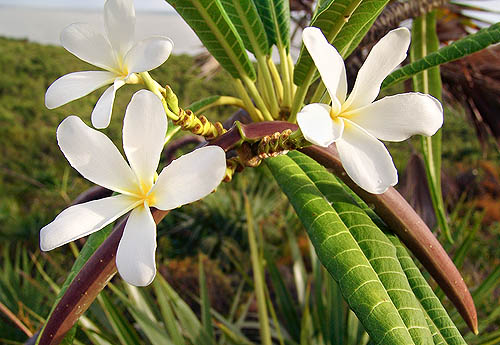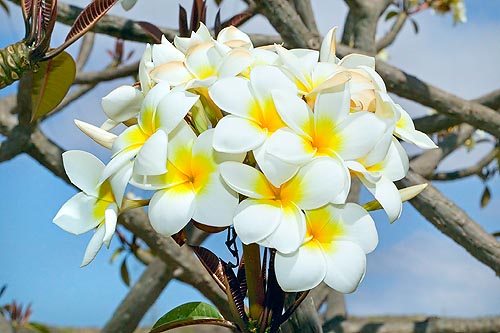Family : Apocynaceae

Text © Pietro Puccio

English translation by Mario Beltramini

Plumeria alba in flower with fruits © Dr. Steven Alexander Sloan
The genus is honoured to the French missionary Charles Plumier (1646-1704), who collected and studied a great quantity of plants of the Caribbean area by the end of 1600.
The name of the species is the Latin name “alba”, with reference to the white colour of its flowers.
Common names: “caterpillar-tree”, “milktree”, nosegaytree”, “pigeonwood”, “wild frangipani” (English); “frangipanier blanc” (French); “alheli”, “aleli”, (Spanish).
Deciduous plant, it appears as a shrub, or as a small or medium size tree, with a rather broad foliage, which can reach about ten metres of height, with greyish stalks which tend to cork with the age.
The leaves are linear, sharp, long up to about 30 cm, of a glossy green colour. Terminal inflorescences with bisexual flowers, funnel-shaped, with a diameter of 7-8 cm, with petals of white colour with a yellow fauces, inodorous.

Often mistaken with Plumeria rubra such as this, with white flowers and yellow fauces © Giuseppe Mazza
The fruits are fusiform, coupled, follicles, long up to about 15 cm, containing several flat seeds provided with a membranous wing which favours their dispersion. It easily reproduces by cutting and by air layering.
Not very diffused plant due to the resemblance with the Plumeria obtusa and the white flower varieties with yellow fauces of the Plumeria rubra which have the advantage of being intensely perfumed and which often, erroneously, are called Plumeria alba.
Plant rather sensible to the low temperatures, outside the tropical and subtropical zones is to be cultivated in pot in order to be sheltered in winter in luminous space with temperatures which are not to get lower than the 12-14°C, and to be replaced in open location in spring, possibly exposed to the south, as, for getting a good blooming, it needs at least 6-8 hours of sun per day.
Synonyms : Plumeria revolutifolia Stokes (1812).
→ To appreciate the biodiversity within the APOCYNACEAE family please click here.
